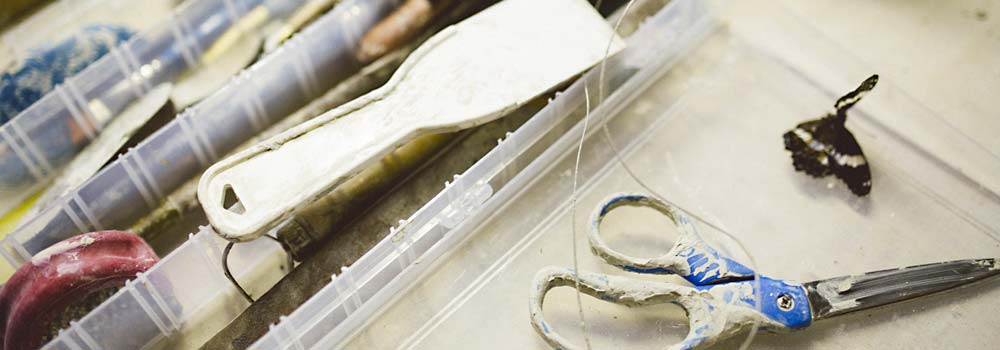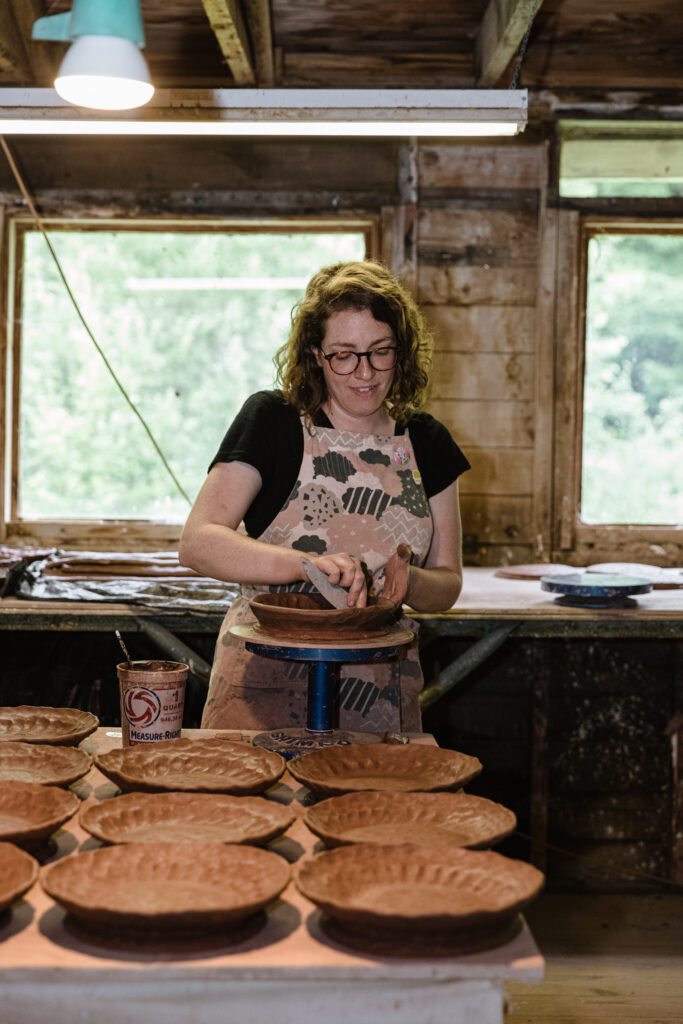
Kari Woolsey at work in the Watershed studio, 2019
When Kari Woolsey signed on to make 550 plates for Watershed’s 2020 Salad Days celebration, none of us anticipated that a world-wide pandemic would bring public gatherings to a sudden halt. While we look forward to hosting our fundraiser in person again, we’re thrilled to offer a highlight of Salad Days this year by featuring Kari’s handmade plates for sale online. We talked with Kari about her work, interests, and experience at Watershed in order to give supporters a better sense of the person behind the colorful plates that anchor 2021’s virtual Salad Days.
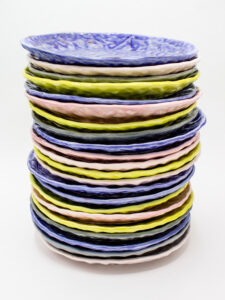
A stack of Kari’s summery plates
Watershed: Kari, tell us about your plates. What was the inspiration for the colors and design?
Kari Woolsey: My work is inspired by everyday domestic objects. These plates have patterns inspired by kitchen linens, while the colors—blue, chartreuse, pink, and gray—were chosen from my favorite aspects of summer: blue skies, lemonade, watermelon, and summer rain showers. I am partial to these colors from my childhood in South Florida but they also reflect my summer at Watershed—swimming in lakes, luscious green of new spring growth, popsicles on a hot day, and the weathered barn studio. I also enjoy the mix and match aspect of the glaze colors and patterns in this body of work. I chose colors that I thought would complement an array of salads and the variety of hand-stamped patterns create an element of discovery when turning over a plate.
WS: How did you approach the production process?
KW: I hand-built my plates using a slab base with an added coil for the rim. I pinched the plates to create an added textural quality. Additionally, the bottom of my plates have a slightly raised pattern. To get the texture on the bottom of the plates, I shaped a slab over a hump mold with a stamped pattern and repeated the pattern on the rims of the plates using hand carved stamps.
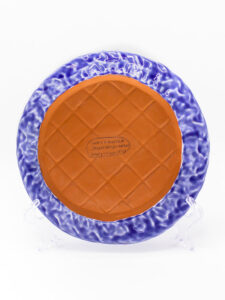
The textured back of a plate
WS: It’s unusual to find such detail on the bottom sides of everyday dishes. Can you share why you chose to give attention to this often-overlooked space?
KW: I incorporated patterns and textures into my Salad Days plates in every way that I could in order to bring attention to the entire plate. The raised pattern on the bottom and the stamped pattern on the rim provide an element of repetition and texture but also offer a way for the plate’s user to explore its surface—whether it’s holding the plate while you fill it up with food or while you wash the plate and leave it in the rack to dry. I wanted to consider every surface throughout the plate’s lifecycle.
WS: What was the most rewarding part of your experience as the Salad Days Artist?
KW: There are a few aspects of the residency that I look back on with so much fondness. I really enjoyed meeting many past Salad Days Artists during the event’s 25th anniversary. I also feel so grateful for the caring and supportive friends I found in the summer staffers and resident artists. I have many fond memories of studio chats, conversations over delicious meals, and swimming in lakes and rivers during my summer at Watershed.
WS: What was the most challenging aspect of producing such a large quantity of plates?
KW: It was challenging to fire such large batches of work. Throughout the three-day process of candling, firing, and cooling, I found it stressful to wait and see how the freshly glazed plates turned out. This got easier the more kiln loads I fired and the more finished pieces I could check off my list to 550 plates.
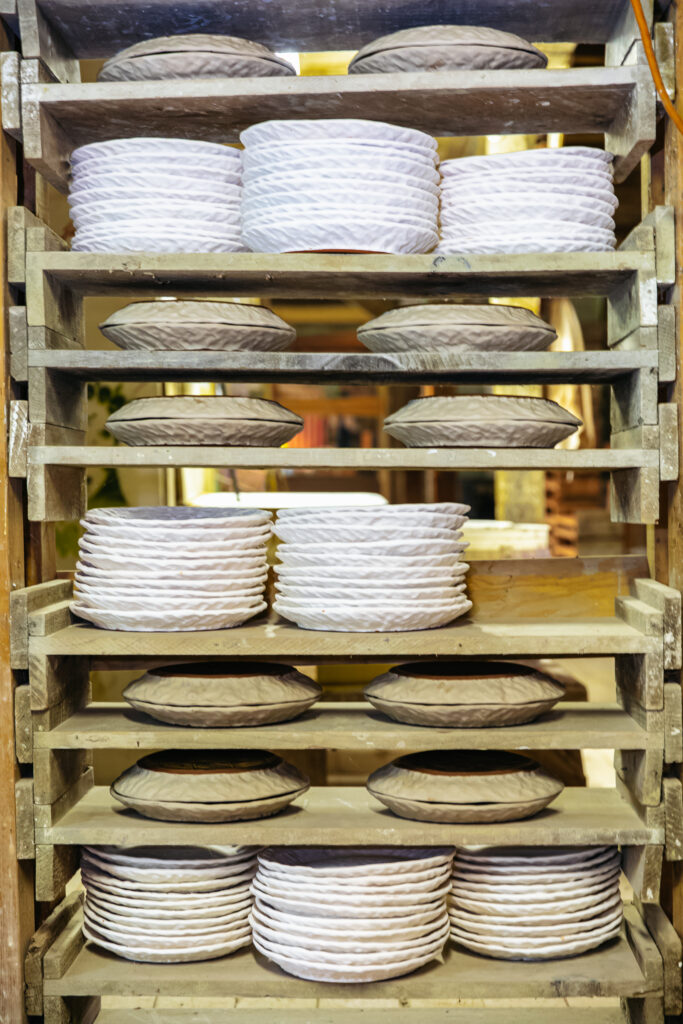
Woolsey’s in-progress plates drying in the studio
WS: How did the experience influence your current work?
KW: Making plates gave me a new perspective on time management. I broke the process into several steps while hand building, slipping, and glazing. The experience provided a benchmark for how much I could accomplish in a very focused environment with a short amount of time.
I also let my mind wander during repetitive parts of the production process. My daily routine in the studio often led to brainstorming sessions. I kept track of new ideas in my sketchbook and have been revisiting those ideas in my current practice.
WS: What other artists’ work do you admire?
KW: There is an endless list of ceramic artists I admire! A few that come to mind are Joanna Powell, Pattie Chalmers, Linda Lopez, Martina Lantin and Future Retrieval, which is a collaboration between Katie Parker and Guy Michael Davis. I am also enamored of Laura Letinsky’s photography and the fiber work of Dee Clements.
WS: What is your favorite memory from your time in Maine?
KW: I loved the walk down to the studio every day. It offered time to clear my head before a day of working. Seeing the variety of roadside flowers blooming and the lambs growing next door at the farm marked the different stages of summer.
Another standout memory took place after the summer residency ended. While finishing up the plates and cleaning out my studio, the remaining staff and I made a pasta dinner with loads of tomatoes from the garden. It was so nice to end the summer with a great group of friends, lots of laughs, and a delicious meal.
WS: What advice would you give future Salad Days Artists?
KW: Find what you need to work best in the studio—whether it’s music, audiobooks, podcasts, swimming breaks, or taking a walk. I listened to many audiobooks and podcasts and asked for recommendations from each group of residents.
At times the workload will seem very daunting, but just keep going. I found it comforting to remember that many artists before me had completed the task. Before I knew it, the summer was over and the plates were finished.
Kari’s plates are on sale online through July 11, 2021. Visit the Watershed Shop.
